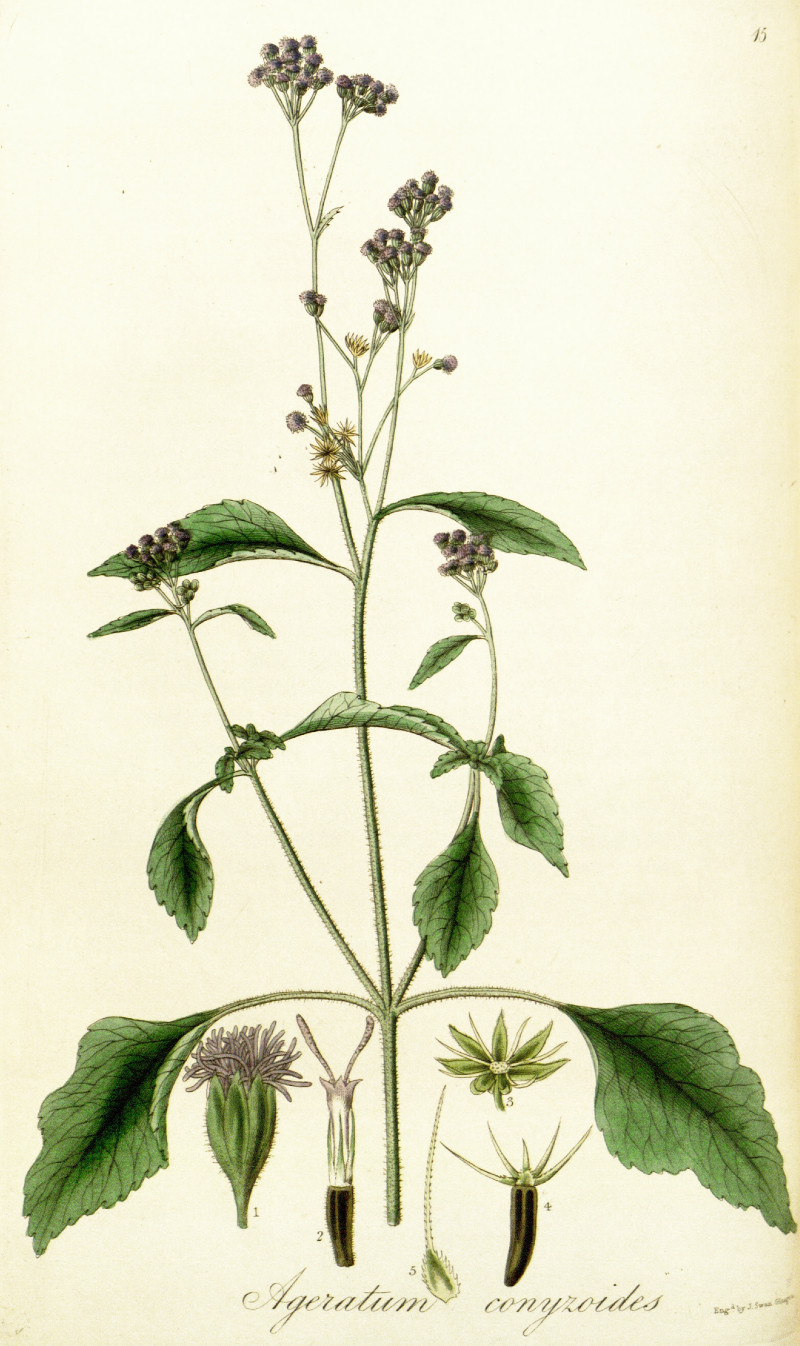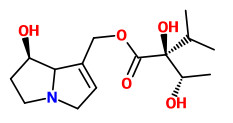Ageratum conyzoides L. - syn.Ageratum ciliare Lour.; Ageratum cordifolium L.; Cacalia mentrasto Vell; Eupatorium conyzoides (L.) E.H.L. Krause. - Asteraceae
goatweed, mentrasto (port.)
Annual herb, up to 1m high, native to tropics,subtropics (America, Africa, Asia); stem pubescent; leaves opposite, crenate; flowers blue to lilac, 4-8mm across.
„As a medicinal plant, Ageratum conyzoides has limited uses due to its toxicity. It is also an insecticide and nematicide. Ingesting A. conyzoides can cause liver lesions and tumors. There was a mass poisoning incident in Ethiopia as a result of contamination of grain with A. conyzoides. The plant contains the pyrrolizidine alkaloids lycopsamine and echinatine.“
https://en.wikipedia.org/wiki/Ageratum_conyzoides
[Plants containing pyrrolizidine alkaloids: toxicity and problems, H. Wiedenfeld, Food Additives & Contaminants: Part A, Vol. 28(3), 2011, 282-292]
„The essential oils isolated from the leaves of Ageratum houstonianum Mill, and Ageratum conyzoides L. by hydrodistillation were analysed by GLC and GC-MS. The essential oil of A. houstonianum contained 7-methoxy-2,2-dimethylchromene (precocene I) and ageratochromene (precocene II) in almost similar amounts (32% and 24% respectively) whereas that of A. conyzoides was rich in precocene I (81%) and poor in precocene II (0.2%).“
[Aromatic plants of tropical central Africa. Part X Chemical composition of the essential oils of Ageratum houstonianum Mill. and Ageratum conyzoides L. from Cameroon., Menut, C., Lamaty, G., Zollo, P.H., Kuiate, J.R., Bessiere, J.M., Flavour and fragrance journal, Vol.8(1), 1993, 1-4]
„Twenty samples of A. conyzoïdes essential oil, extracted from the leaves and the roots collected in Congo during different periods of the year, are analysed by GC-MS. The content of essential oil varies randomly from 0.11 to 0.58% for the leaves and from 0.03 to 0.18 To for the roots. Oils from leaves and roots show a certain homogeneity of chemical composition. Main constituents are: β-caryophyllene (1.2 to 25.1%) and precocene 1 (63.0 to 92.9 %).“
[L'huile essentielle de Ageratum conyzoïdes., Wandji, J., Bissangou, M.F., Ouambra, J.M., Silou, T., Abena, A.A., Keita, A., Fitoterapia, Vol.67(5), 1996, 427-431]
 precocene I (R=H) and precocene II (ageratochromene, R=OCH3)
precocene I (R=H) and precocene II (ageratochromene, R=OCH3)
„The plant grows commonly in waste and on ruined sites. It has a peculiar odour likened in Australia to that of a male goat and hence its name 'goat weed' or 'billy goat weed'.
The essential oil obtained from plant has been reported to have a powerful nauseating odour and found to be poisonous to rabbits due to the presence of HCN and coumarin. The herb is not eaten by humans except for medicinal purposes, but in some cultures, it is a delicacy for domestic guinea-pigs, horses, cattle, and also used to feed fish.
The weed has been known since ancient times for its curative properties and has been utilized for treatment of various ailments, such as burns and wounds, for antimicrobial properties, for many infectious conditions and bacterial infections, arthrosis, headaches and dyspnea, pneumonia, analgesic, anti-inflammatory, antiasthmatic, antispasmodic and haemostatic effects, stomach ailments, gynaecological diseases, leprosy and other skin diseases. A wide range of chemical compounds including alkaloids, cumarins, flavonoids, chromenes, benzofurans, sterols and terpenoids have been isolated from this species. Extracts and metabolites from this plant have been found to possess pharmacological and insecticidal activities.
The water soluble fraction of the plant extract produces peripheral analgesic activity and an anti-inflammatory action, which seems to occur in leucocyte-dependent inflammatory events. Silva et al ., investigating the effect on smooth muscles using isolated rat uterus and intestine smooth muscles, concluded that the fraction possesses substances, which provoke direct relaxing effect on smooth muscles and inhibit contraction induced by several agonists possibly by blocking the entry of calcium and/or inhibiting cAMP phosphodiesterase. These pharmacological characteristics could explain the popular use of AC to alleviate abdominal and menstrual pains.“
[Kamboj A, Saluja AK. Ageratum conyzoides L.: A review on its phytochemical and pharmacological profile. Int J Green Pharm 2008;2:59-68]
http://www.greenpharmacy.info/text.asp?2008/2/2/59/41171
„Ageratum conyzoides belonging to Asteraceae is a common weed found everywhere in India and commonly known as goat weed, white weed, in various parts of India. The leaves are applied to the wounds act as septic and heel them quickly. The juice of the fresh plant and extract of dried plant are used to cure allergic rhinitis and sinusitis… on 16 th post wounding day, Group-I animals showed 75.14% of healing (which may be due to self immunity of the animals) where as Soframycin treated animals showed 100.00% healing. On the other hand, the Ageratum treated group showed 90.90% of wound healing. Also, polyhebral treated group shows 95.94% healing… it is possible to conclude that the ointment of the root extract of Ageratum conyzoides has significant wound healing activity.“
[Simple evaluation of wound healing activity of polyherbal formulation of roots of Ageratum conyzoides Linn., Sachin, J., Neetesh, J., Tiwari, A., Balekar, N., Jain, D.K., Asian J Res Chem, Vol.2(2), 2009, 135-138]
http://www.ajrconline.org/ajrc_vol2_2/11-84.pdf
„Inhibitory effects of essential oil of Ageratum conyzoides, on the mycelial growth and aflatoxin B1 production by Aspergillus flavus were studied. Cultures were incubated in yeast extract-sucrose (YES) broth for days at 25 °C at the following different concentrations of the essential oil (from 0.0 to 30 μg/mL). The essential oil inhibited fungal growth to different extents depending on the concentration, and completely inhibited aflatoxin production at concentrations above 0.10 µg/mL. The analysis of the oil by GC/MS showed that its main components are precocene II (46.35%), precocene I (42.78%), cumarine (5.01%) and trans-caryophyllene (3.02%). Comparison by transmission electron microscopy of the fungal cells, control and those incubated with different concentrations of essential oil, showed ultra-structural changes which were concentration dependent of the essential oil of A. conyzoides. Such ultra-structural changes were more evident in the endomembrane system, affecting mainly the mitochondria. Degradation was also observed in both surrounding fibrils.“
[Ageratum conyzoides essential oil as aflatoxin suppressor of Aspergillus flavus., Nogueira, J.H., Gonçalez, E., Galleti, S.R., Facanali, R., Marques, M.O., Felício, J.D., International journal of food microbiology, Vol.137(1), 2010, 55-60]
„Aqueous extracts of Ageratum conyzoides L. harvested in Brazil (commercial, flowering and non-flowering samples) were prepared according to the prescribed method and analyzed by HPLC-HRMS. The pyrrolizidine alkaloids lycopsamine, dihydrolycopsamine, and acetyl-lycopsamine and their N-oxides, were detected in the analyzed extracts, lycopsamine and its N-oxide being known hepatotoxins and tumorigens. Together with the pyrrolizidine alkaloids identified by HPLC-HRMS, thirteen phenolic compounds were identified, notably, methoxylated flavonoids and chromenes. Toxicological studies on A. conyzoides are necessary, as is monitoring of its clinical use. To date, there are no established safety guidelines on pyrrolizidine alkaloids-containing plants, and their use in Brazil.“
[Pyrrolizidine alkaloids in medicinal tea of Ageratum conyzoides, Bosi C.F. et al., Revista Brasileira de Farmacognosia, Vol.23(3), 2013, 425–432]
„The chemical composition of the hydro-distilled essential oils of leaf, flower, stem and root of Ageratum conyzoides L. were analyzed by gas chromatography… The major constituents were 6-demethoxy-ageratochromene (precocene I) and β-caryophyllene dominated in leaf (72.3%; 12.1%), stem (66.5%; 10.2%), flower (50.3%; 14.6%) and root (79.3%; 6.0%) essential oils. The compound ageratochromene (precocene II) was found relatively high amount in flower (10.5%) than leaf (3.1%), root (0.4%) and stem (0.3%) oils. The occurrence of androencecalinol is being reported for the first time in leaf, flower, stem and root oils in low quantity (0.7 - 0.3%).“
[6-Demethoxy ageratochromene (Precocene I) Rich Essential Oil of Ageratum conyzoides L. from Western Ghats Region of North West Karnataka, India., Joshi, R.K., Journal of Essential Oil Bearing Plants, Vol.17(3), 2014, 422-426]

Hooker, W.J., Exotic Flora, vol.1, t.15 (1823)
http://plantgenera.org/species.php?id_species=29376
